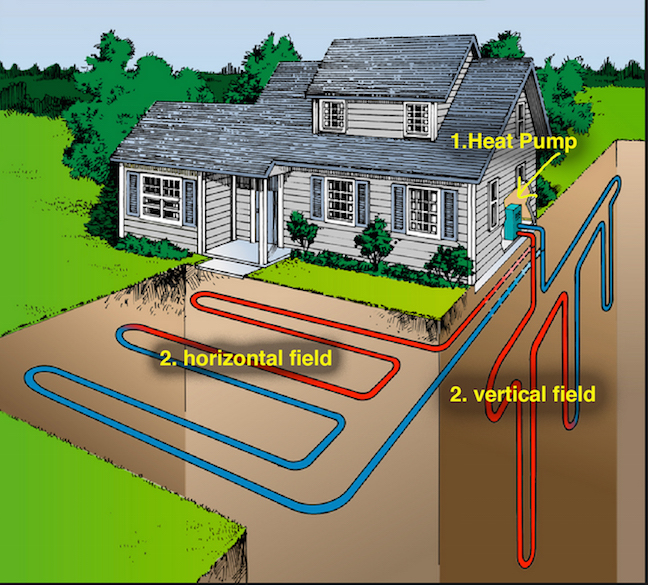Your home’s property sits above a vast field of renewable, inexpensive heat, and the soil or water below is also an efficient place to discharge heat when cooling your home.

Digging the Ground horizontally or drilling a well for Geothermal Heating and Cooling – Planning Phase via renewableenergyworld.com
It will take significant site planning, permitting, dirt work and possibly drilling to tap into the earth’s sustainable geothermal heating and cooling potential. While the process varies slightly among municipalities, you’ll have to take these or similar steps to meet development and building code requirements:
- Submit a site plan to the planning/development office for approval
- Obtain approval from state and/or federal environmental agencies for wells that use surface bodies of water
- Use the approval(s) to obtain permits for excavation, well drilling and geothermal system installation
The geothermal heating and cooling contractor you use will work with you on obtaining the necessary approvals and permits, but when you know what steps must be taken, you’ll be sure the project is handled properly from planning to installation of the ground source heat pump (GSHP) system.
Here’s more detail on each step:
Site Plan: What it Is and How to Get a Site Plan
Permits cannot be obtained without a site plan drawing. The plan allows the permitting agency to understand what is being proposed and exactly what it is approving.
A site plan is called a plot plan or a concept plan in some communities. The purpose of this scale drawing is to illustrate the layout of your property including the proposed site for the geothermal trenches or wells. Geothermal site plans or plot plans show some or all of the following:
- True north
- Lot boundaries and dimensions
- Position of the home, garage, deck, patio and outbuildings
- Driveway and walkways
- Location of the well
- Location of septic tanks and outline of the drain field
- Large trees
- Underground utilities
- The proposed location of geothermal system wells or trenches and their specifications
Trenches vs. Wells: Horizontal loops, often using coiled tubing for optimal space use, in long trenches are the most affordable loop type. The trenches are typically dug with some type of excavator to a depth of 4-8 feet and a width of about 3 feet. Most are 300-400 feet long where possible. They are carefully backfilled once the tubing is installed.
Wells are necessary where the lot size won’t allow for trenches or the specific system requirements call for them. Expect one well per ton (12,000 BTUs) of heating capacity, though larger wells can be used instead of more wells in some systems. Wells are typically 200-400 feet deep, and they’re spaced 15-30 feet apart.
Having a Site Plan Produced: 24hPlans can produce a site plan quite affordably in about a day. Rush orders can be completed in as little as two hours during business hours.
There’s no need to pay the high cost of an engineer for the service. Our drawings are just as detailed and accurate, and they’re approved every day by communities around the country.
Obtaining Approval of an Environmental Agency
An open-loop geothermal heat pump system that discharges to a surface water body might require a National Pollutant Discharge Elimination System (NPDES) permit too. They’re administered through the state, though it’s a federal program.
Your state’s permit might use the state abbreviation, as in Arizona where it is called the AZPDES. The permit is obtained from the EPA.
Your contractor will have details on obtaining the permit, if needed. The annual cost of the NPDES permit varies from $2,500 to $10,000 depending on the size of the GHPS installed.
Geothermal Heating and Cooling Permits
Once you’ve had a site plan approved and received any necessary environmental permits, you’re ready to apply for the local permits required to begin work and to have it inspected along the way to ensure it is being done properly. Among the permits required are these, though their names might differ where you live:
Excavating/grading permit:
Your property is about to undergo a lot of dirt work, especially if a horizontal-loop system is being installed. The permit will ensure that the excavation doesn’t interfere with a well, septic system or utility lines and that once the work is completed, the disturbed ground is properly backfilled and graded for drainage away from your home or neighboring homes.
Well permit:
If one or more vertical wells are being dug, a well permit is required. The permit allows your local officials to track the location of wells, how deep they are and at what depth water was reached. The data is used to map local aquifers.
Mechanical, plumbing and electrical permits:
These permits cover all aspects of the installation of the GSHP system including the loop, mechanical components such as the heat pump and heat exchangers and any electrical or plumbing required. Expect at least two inspections for each aspect of the work.
Note:
24hplans has team of highly-trained, professional architects and drafters who can prepare any kind of site plan in the shortest amount of time possible, so that you can easily obtain that building permit and get on with your project. Use the promotion code: 24hplans-20off to get a 20% discount off any package. — Please note this is a limited time offer, exclusive to the readers of our blog. This offer is not being advertised anywhere else.


Leave A Comment